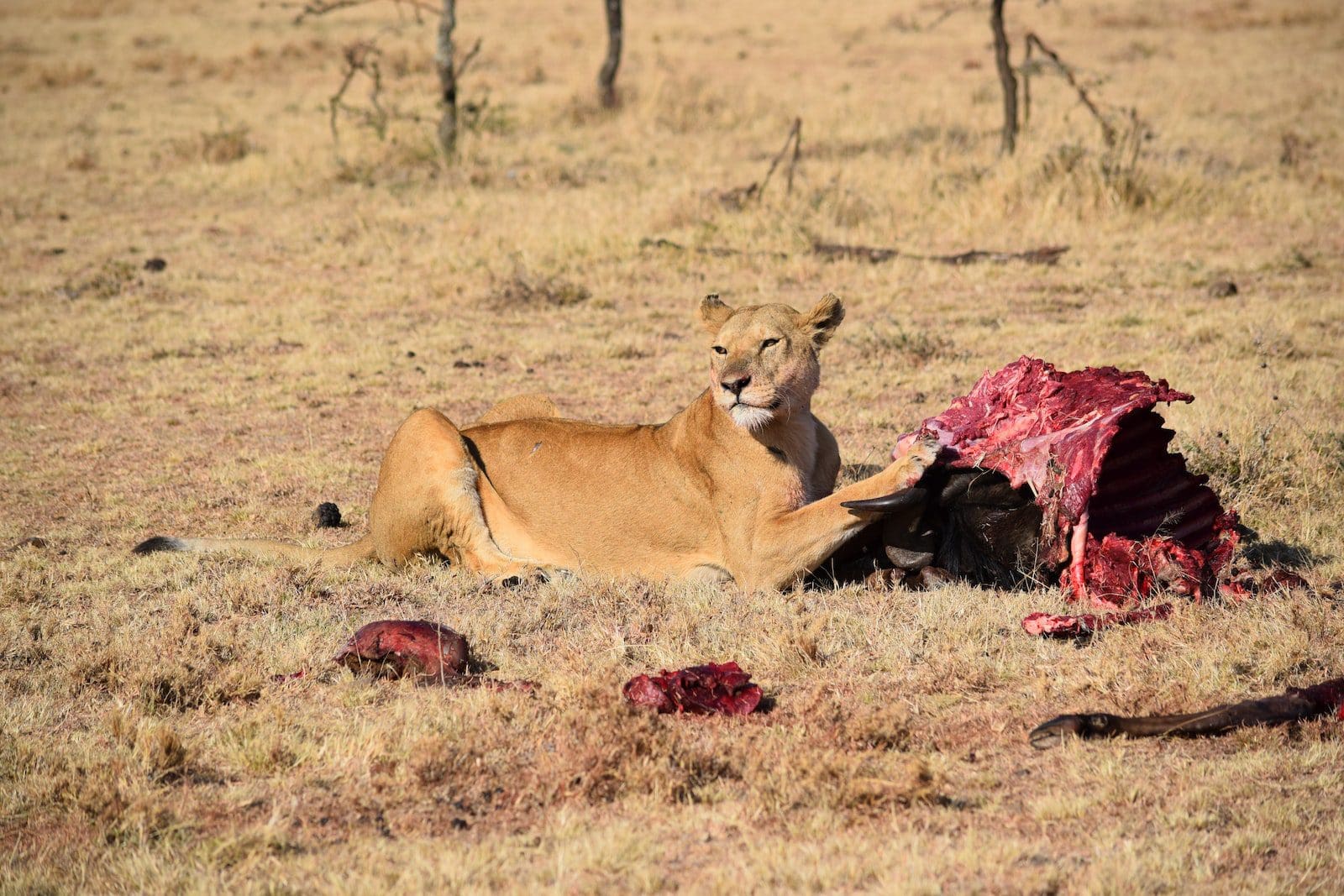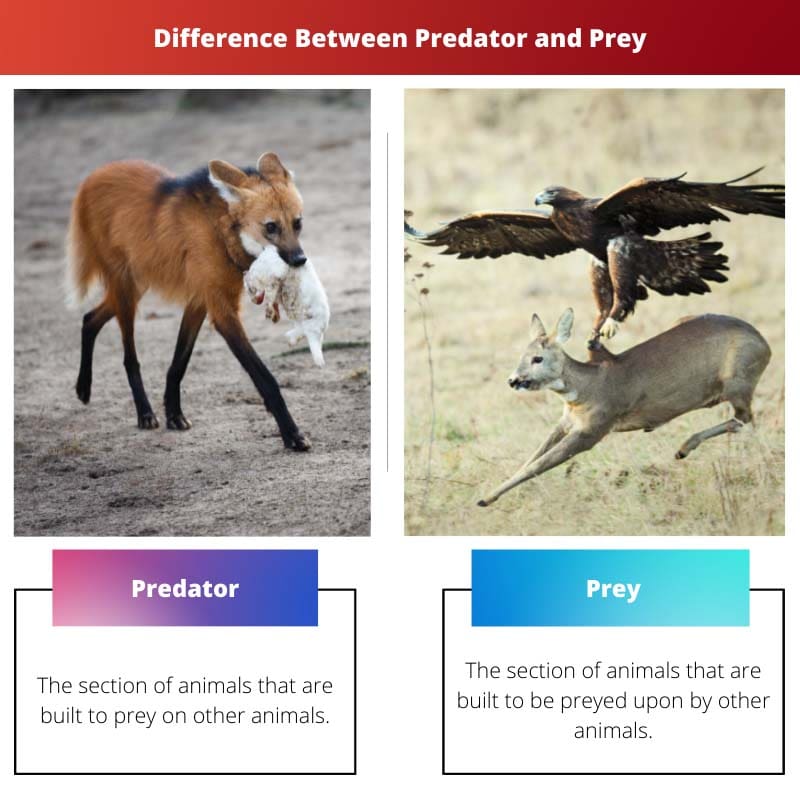Over some careful mulling, we will come to realize that each animal has a role to play. They are all built in a manner to meet their bodily needs and to adapt to their surroundings with ease.
Some become the predators, and others become the prey, but all of them are indispensable.
Key Takeaways
- Predators are animals that hunt and kill other animals for food, while the prey is animals that are hunted and killed by predators for food.
- Predators have adaptations such as sharp claws, teeth, and keen senses to catch prey, while prey have adaptations such as speed, camouflage, and defensive mechanisms to evade predators.
- Predators have a lower population density than their prey due to the energy required to hunt and kill, while prey species can have much higher population densities.
Predator vs Prey
A predator is an animal that hunts and kills other animals for food. Predators are larger and stronger than their prey. Examples include lions, tigers, wolves, eagles, and sharks. Prey are animals that are hunted and killed by predators. Prey have adaptations that help them avoid or escape from their predators. Examples include rabbits, deer, zebras, gazelles, and mice.

Predators can be defined as the section of animals that are built to prey on other animals.
These animals are of a sturdy constituency, coupled with a strong set of jaws and sharp dental constitution to help them tear their prey apart. They are bigger than their prey and more agile.
On the other hand, Prey can be defined as the section of animals that are built to be preyed upon by other animals.
These animals are of a sturdy yet weaker constituency, coupled with a dental constitution that is more suited to chewing grass or anything that is not difficult to be torn apart.
Comparison Table
| Parameters of Comparison | Predator | Prey |
|---|---|---|
| Meaning | The section of animals that are built to prey on other animals | The section of animals that are built to be preyed upon by other animals |
| Dental Constitution | They have a sharp and sturdy dental constitution to help them tear their prey apart | They have a dental constitution that is more suited to chewing grass or anything that is not difficult to be torn apart |
| Size | They aren’t always bigger than the animals they prey upon but are more powerful | Sometimes these animals are bigger than their hunters but weaker |
| Food Chain Stages | They constitute the last or stage nearing the end of the chain | They come before the predators |
| Dependency | They are solely or largely dependent on their prey for survival | They aren’t dependent on the predators at all |
What is Predator?
A predator can be defined as a section of animals that is built to prey on other animals.
These animals are of a sturdy constituency, coupled with a strong set of jaws and sharp dental constitution to help them tear their prey apart. They are bigger than their prey and more agile.
This section falls towards the end of a food chain as they depend on other animals for their survival. Not all of them are only carnivorous. Some of them are omnivorous. For instance, a bear eats fruits, berries, honey, and fish.
They aren’t always bigger than their prey, but they possess a variety of skills that help them keep up with the pace and characteristics of their prey.
For example, a lion is by no means bigger than a giraffe. However, it can hunt down a giraffe by using a giraffe’s vulnerabilities against it.
Certain animals can camouflage so well that they can easily fool their prey. For instance, a Royal Bengal tiger, as we all know, bears orange and black stripes.
This is a color combination that easily stands out in the geographical terrain in which species thrive.
However, it goes unspotted by its prey, a deer, as deer cannot see the color orange, and the tiger appears black and white amidst the tall grasses surrounding it, thereby successfully camouflaging and fooling the deer.

What is Prey?
Contrastingly, it is the section of animals that are preyed upon by other animals.
These animals are of a sturdy yet weaker constituency, coupled with a dental constitution that is best suited to chewing grass or anything that is not difficult to be torn apart.
This section falls at the beginning of a food chain as they depend on plants for their survival and not on other animals. Therefore, it is abundantly clear why these animals are herbivorous.
However, certain carnivorous animals eat grass when facing stomach problems but are certainly not omnivorous.
Sometimes these animals are bigger than their hunters but weaker. For instance, an elephant is much bigger than a cheetah and more powerful than it, yet it surrounds by two or three cheetahs.
An elephant can easily fall prey to them. Its gigantism makes it extremely difficult for it to move fast, at least fast enough to save itself from the grips of a cheetah.
Though weak, these animals are also great at camouflaging or confusing their predators with their features.
For instance, a zebra is found in regions with scanty trees and shrubbery, making it tough for it to hide, but its black and white stripes are of such a pattern that when a zebra runs at great speed, it can even confuse a predator such as a lion, thereby, allowing it to escape not with ease though.

Main Differences Between Predator and Prey
- Predators are the section of animals that kill other animals to survive and do not feast on grass or leaves. On the other hand, Prey is the section of animals that are built to be preyed upon by other animals.
- Predators have a sharp and sturdy dental constitution to help them tear their prey apart. However, preys have a dental constitution that is more suited to chewing grass or anything that is not difficult to be torn apart.
- Predators aren’t always bigger than the animals they prey upon but are more powerful. In contrast, preys aren’t as big or strong as their predators.
- Predators are carnivorous, but certain animals are omnivorous. For instance, a bear eats fruits, berries, honey, and fish, whereas preys are always herbivorous.
- While predators are solely or largely dependent on their prey for survival, preys aren’t dependent on the former at all.

- https://esajournals.onlinelibrary.wiley.com/doi/abs/10.2307/1934346
- https://www.cabdirect.org/cabdirect/abstract/19901426706

The descriptions of predators and prey are vivid and well-explained, making it an insightful read. Well done!
The article effectively portrays the distinct characteristics and behaviors of predators and prey.
This post provides an interesting analysis of the roles of predators and prey, showing different characteristics and how they are related.
I agree, this analysis is detailed and well-researched.
This article offers a detailed exploration of the behavior and characteristics of both predators and prey. Well-researched and informative.
I appreciate the scientific approach taken to explain the roles of predators and prey.
The post provides valuable insights into how predators and prey interact in nature.
The comparison table is particularly helpful in understanding the differences between predators and prey. It’s an insightful read.
The explanation of predators and prey provides a clear understanding of their roles in the ecosystem.
Yes, it’s a great way to summarize the main points of the post.
The detailed explanation of predatory and prey behaviors is commendable. The post offers a wealth of knowledge on this subject.
This article thoroughly explores the roles of predators and prey, shedding light on their significance in the ecosystem.
The examples used to illustrate the traits of predators and prey are very effective in conveying the information. It’s an enlightening read.
I found the examples to be useful in understanding the concepts discussed in the post.
The article presents a thorough examination of the roles of predators and prey, offering valuable insights into their behaviors and adaptations.
An impressive analysis of predator-prey relationships, providing a deeper understanding of their significance in nature.
The post delivers a comprehensive overview of predators and prey, highlighting their importance in ecological systems.
The post effectively highlights the unique traits and dependencies of predators and prey. I found it to be an engaging piece of writing.
The natural world is truly fascinating, and this article presents a compelling discussion of predator-prey relationships.
The section on predator and prey behavior offers valuable insights into animal adaptations and survival strategies.
The scientific explanations provided in the post add depth to our understanding of predators and prey. It’s thought-provoking.
The relationships between predators and prey are explored in a comprehensive and detailed manner in this post.
I enjoyed learning about the dynamics of predator-prey relationships and how they contribute to the balance of nature.
This is a very educational article that delves deep into the dynamics between predators and prey. I appreciate the level of detail provided.
I agree, the post offers a comprehensive explanation of the subject.
The post highlights the importance of predators and prey in the natural world and how they contribute to the ecosystem.